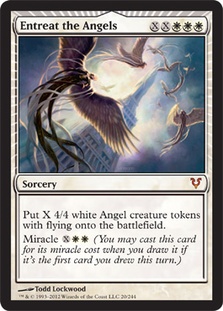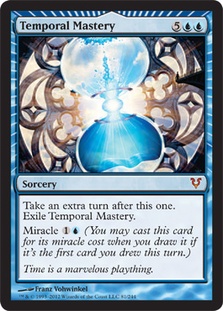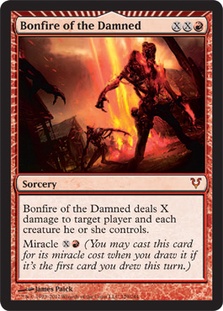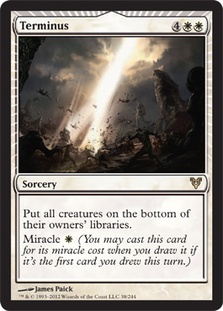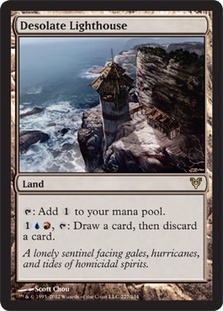Warning: Spoilers!
Avacyn Restored is nearly fully spoiled, and by the time you read this, the final 37 cards may have already been unveiled by WotC. Already we have been hit with quite a few major format-changing cards. We have also had a couple cards revealed that seem to be at costs that I would have to imagine are intentionally “over the curve” in ways that surpass any previous cards in those areas. Obviously, you have to take chances if you want to keep things exciting, fresh, and interesting, but when you just give a card too good a rate, like Lingering Souls, it can have unintended consequences.
Snapcaster Mage is probably the poster boy for power level gone wrong at this point. It’s amusing to see the arguments that it’s really Delver of Secrets’ fault and not Snapcaster Mage’s. The argument goes something like: every Standard Delver deck has four Delvers, while many Snapcaster Mage decks have only two or three Snapcasters. Of course this is ridiculous, since ever Delver deck has four Snapcasters and all those decks with two or three Snapcasters have zero Delvers. It’s not that they are only playing two or three Snapcasters because Snapcaster isn’t good enough to be more than a two or three of their small creatures. Actually they want zero small creatures; it’s just that Snapcaster Mage is so far beyond reasonable that they want to play him anyway.
Are there some non-zero number of 4x Delver decks in Legacy that have less than four Snapcasters? Sure, but if we’re going to bring formats that real into the discussion, than I’d like to point out that Snapcaster Mage is better than Delver in Vintage.
Delver of Secrets is definitely overpowered, no question. It’s on the Wild Nacatl curve and is Top 10 creature-creatures of all time (as opposed to creatures like Hermit Druid, Narcomoeba, Golgari Grave-Troll, and Goblin Recruiter). Snapcaster Mage happens to be on the Tarmogoyf / Stoneforge Mystic level, that’s all.
The real problem isn’t Snapcaster Mage or Delver of Secrets being “mistakes.” The real problem was both of those mistakes were made at the same time that WotC was giving a pass to Mana Leak and Ponder, cards they knew were pushing the limits. However, this is not that article.
This article is about looking for Strangleroot Geist, Primeval Titan, and Swords. All of these cards are “over the line.” This article is also about looking for Geralf’s Messenger, Gravecrawler, Phantasmal Image, Consecrated Sphinx, Hero of Bladehold, and more. This article is about looking for Avacyn Restored’s power cards; its actual top tier.
It isn’t just about finding the aces, though. It’s about being open to the aces being cards that are of a sort that isn’t generally pushed to this level (if ever before). It is comical just how much people underrate cards that are good in a new way and overrate cards that allude to a card that was popular before. If it was random which cards turned out to be the best and which were just illusions, perhaps this mistake would be more excusable. However, there is a very clear method to the madness. WotC isn’t behaving at random; they are designing the best game in the world, and they are damn good at it too. Maybe it is worth spending a little time meditating on this method and putting ourselves in their shoes. Which cards would we push if we were them? Obviously, they are going to make mistakes (like Delver), but seeing things from their position does 85% of the work for us…
Do you suppose they would ship without some of the Miracle cards being absolutely awesome in Constructed? How about the Angels? Just curious…
Impressive.
So let’s break this one down for a minute, because with all this hoopla about Temporal Mastery and Reforge the Soul, I have heard relatively little about this monstrosity. Isn’t this card just incredible?
When evaluating miracles, there are a number of costs that most players overlook, causing them to think some of the higher variance miracles are overpowered. They are looking at the best-case scenario: the Time Walk costs two scenario. The key to properly evaluating miracles is to understand what they are when you can’t miracle them, as well as how often you get a discount (and how much).
Time Warp is not an inherently top rank card. If you have Temporal Mastery in your first nine cards of the game, you have to pay a two-mana premium (and seven mana is just about three times as much mana as five power level wise, no exaggeration). Then starting on turn 3, you have a chance to save three mana on an effect that untaps your lands. This is good, but how good? It’s not just how often you are going to miracle the Mastery, but how often you’re going to do it when it’s relevant. You can’t save it for the best possible turn, like Time Warp. You can’t protect it and set it up. More importantly, the first nine cards are extremely important for determining the outcome of the match. In general, every card down in your deck is less important for determining the result than the one before it. This means that even if your games are not over by turn 11 (which is eighteen cards deep), we still aren’t talking a 50-50 split. The card you draw on turn 11 is not as likely to change the outcome as the card you draw on the first turn. Additionally, this doesn’t factor in if you were trying to draw extra cards in ways that don’t miracle.
We discussed Bonfire of the Damned, last week; one of miracle cards that I think will turn out to be a good Constructed card. Part of the beauty of Bonfire of the Damned is that even when you cast it for three mana or for five mana, you’re not actually getting that bad of a deal. Marsh Casualties that deals one to the opponent and is easier to cast, albeit at three, is not amazing but totally reasonable. You can even still kick it for five mana, at which point it actually passes Casualties due to being easier to cast and dealing two damage. To sweeten the pot even more, you have the option to build up to even larger versions which are totally reasonable (seven mana for 3/4ths of a Flame Wave that is easier to cast is not a bad option). This is a card that is better than Marsh Casualties.
And we haven’t even gotten to the miracle yet.
When you miracle Bonfire of the Damned, you get to Fireball your opponent and all of his or her creatures (without targeting). Is this going to be a good option on turn 3? Not usually; however, as we determined, Bonfire of the Damned on the backup plan is still a solid card. Starting on turn 4 or 5, however, your deck is just loaded with a number of overpowered options. Spending five mana to deal five to an opponent and all of his or her stuff is often going to be game winning on turn 6.
On balance, it’s important to not overlook the cost of having to play the card immediately to get the miracle discount. We don’t always want to play Earthquake the turn we draw it. It’s very possible that if you draw Bonfire of the Damned that it’s right to play it for the miracle cost and get a nice little two-for-one, but this isn’t the same as Bonfire only costing XR. If it had actually cost XR, you would have held it and saved it for a couple more turns to make it even more effective.
The counter to this, of course, is that you don’t have to play it when you draw it. This only reinforces how important it is to evaluate how good the miracle cards are when they are not powered up, as that is going to be the more common way to draw them when they are relevant. This brings us back to Entreat the Angels.
How good is Entreat when it’s powered down?
Five mana to make a 4/4 flier is not going to break any records these days, but it’s not bad. Fliers are very valuable these days, and it’s a convenient size for taking over (blocking Delver, Strangleroot Geist, etc.). Triple white is a lot, but mana is pretty easy nowadays and if you’re able to actually support it, it’s not that big of a deal. It’s more just a question of who gets to play it or not. This isn’t just five mana no vigilance Serra, however.
For seven mana we are now getting Broodmate Dragon. It does cost a mana more, but it has the option to be played a turn before Broodmate would to give you half of a Broodmate (if you need it). Additionally, if the game goes long enough it gives you the occasional option to buy a third flier for nine mana. Ambitious, to be sure, but not unreasonable. At this rate alone, Entreat would be under Broodmate Dragon, but not by all that much. And frankly, Broodmate Dragon is a pretty impressive bar.
And we haven’t even gotten to the miracle yet.
Entreat does power up until turn 4 (where you’d only get to do it for three mana). What does it do then? Three mana for a 4/4 flier is unquestionably a great rate, though to be fair, there’s a good chance you’ll waste your final mana from your land drop. It’s interesting to consider just how comes into play tapped lands will work with miracle X-spells (read: well).
What about turn 5? At that point you get Broodmate Dragon for four mana, which is just absurd. Even if you waste your fifth mana, you are in really, really good shape. Turn 6? Ok, at this point, you are starting to go off the hinges. Three 4/4 fliers is more than enough to totally turn around a lot of games that were so hopeless you needed an actual extremely unlikely and fortunate event. Some opponents could burn you out, others may have a Leak, while others could have a Ratchet Bomb. For the most part, however, you are going to win the majority of games you draw Entreat turn 6 or later. There are going to be more than a few games where you draw Entreat the Angels and put over thirty or forty power worth of Angels into play!
Is this win more? Well, only in the same way Splinter Twin + Deceiver Exarch is win more. You may be dealing way more damage than you need, but you are dealing enough to win the game.
What if the miracle cards weren’t spread out evenly? I’m not even talking no black miracles (which is the case for flavor’s sake). I’m just talking power level. What if white is really the miracle color? What would it take for another white card to be in the same discussion as Entreat the Angels?
What do we get when we get the “downside” of Terminus? While Bonfire is actually better than Marsh Casualties and Entreat is less than a mana worse than Broodmate Dragon (probably closer to half a mana), very clearly this is a Hallowed Burial for one mana more. While this is not as bad as two mana more than Time Warp (which is not as good a card as Hallowed Burial anyway), this is still a very real cost.
How good is Hallowed Burial in the format? Well, Day of Judgment is certainly a major player in the format, but Hallowed Burial would actually probably be a little better due to Strangleroot Geist, Geralf’s Messenger, Gravecrawler, Chandra’s Phoenix, Doomed Traveler, Loyal Cathar, Wolfir Avenger, and more. Wafo-Tapa and I used to play Hallowed Burial in our Extended five-color control decks when we had Wrath of God and Damnation as options. The ability to hit Sprouting Thrinax and Vengevine was worth so much that we happily paid the extra mana. There are more reasons than ever to prefer Hallowed Burial to Day of Judgment, and it’s not clear that we wouldn’t want some number of six-mana Hallowed Burials straight up these days.
And we haven’t even gotten to the miracle yet.
Hallowed Burial for one is obviously a significant discount, though it’s important to once again remember that reactive miracles are going to be miracled less than proactive ones. Time Walk is usually worth playing at any point in the game. Hallowed Burial is the type of effect you might only choose to miracle half of the time you even have the option. Still, in those spots where you do it kills everything for just one, avoiding graveyard shenanigans. That is a really, really good rate.Â
This is an incredible tempo swing that can be paired with a planeswalker to totally take over a game. The Magical Christmasland scenario is basically “win-the-game,” but the important thing to remember is that even when you can’t “kick it” it’s still a very reasonable card.
How good do I think the miracle cards are? A bunch of them are really, really good. It’s not that the miracle mechanic is inherently overpowered. It’s just that this particular selection of miracle cards are pushed an impressive amount and will be having a big impact on Constructed Magic.
Why did WotC do this? Isn’t this just making the game more luck based? Look, it wouldn’t surprise me if half of the ten best Magic players in the world thought that miracles being good make Magic worse on account of adding variance.
I got a feeling that ten out of ten of the best game designers on Earth would be on board…
Look, there are a lot of misconceptions about variance in games. There are also a lot more types of variance than most people realize. Frequency of variance, impact the variance has, variance in how the game plays out one game to the next. Can skill overcome even strong variance swings the one way? Can variance overcome even strong skill swings the other way?
The miracle mechanic involves lots of variance, but that is by design. Magic is a very complex game with an incredible amount of skill involved. Sometimes players (and often strong players) will compare the variance in card design today with that from fifteen years ago and complain that there is more variance these days. The truth is WotC has just gotten much, much better at design. They have mastered using this variance to create a game that is both extremely skill testing and extremely fun.
Complicated lines of permission battles after countless library manipulation spells is certainly going to be extremely skill testing of a particular skill set, but there is so much more to Magic. Yes, the better player (at those skills) may have won a higher percentage of the time fifteen years ago in some matchups, but if you look at the Pro Tour today compared to the Pro Tour fifteen years ago, there is some pretty compelling evidence that Magic is more skill testing than ever.
Fifteen years ago, there were maybe a million players, maybe two. Of these players, maybe a couple hundred thousand played in tournaments. Of the top performing players of that era, some very non-zero number had their numbers augmented by cheating. Of those that earned their results fairly, how many put up the kind of numbers that LSV, Paulo, Kibler, Wrapter, Shuhei, Juza, and the like put up? Now remember, the players of today have to compete with twelve million Magic players, including over 1.2 million dedicated tournament players!
It’s not that the game was “easier” back then (or harder). It’s that different skills were being tested. Fifteen years ago, a lot more of the skill was at being cutting edge at figuring out how Magic’s physics engine even worked. Fifteen years ago, there were maybe fifty people on Earth that were not embarrassing at Draft by today’s standards. However, back then zero people had access to the information, the Magic theory technology, which we do today.
In the world where most people don’t know what they are doing, being one of the few people that does gives one an incredible advantage. It’s easy for a very strong player to miss that era of innocence back when they could see in the land of the blind. They remember cards like Necropotence, Forbid, Impulse, Survival of the Fittest, Tradewind Rider, Armageddon, Living Death, Force of Will, Brainstorm, Oath of Druids, Land Tax, Mystical Tutor, Thawing Glaciers, and Demonic Consultation and imagine some idealized world where those were the real skill testing cards. Nowadays, the world of Titans and Delver flips is too luck based since they don’t win as high a percentage of their games against the random dude as they used to.
That’s a delusion.
The truth is hate it as you might, you can’t go back. Whatever format you remember from more innocent days would not play out the same today as it did then. People are too good at Magic, now. This takes nothing away from the accomplishments of yesteryear. Far from it! Pioneering Magic technology is huge, but players today would generally kick the tar out of players from fifteen years ago.
Modern Chess is over 500 years old, though it was built on games that had existed for over a thousand years. If we were to take the top 50 players from the first 100 years of Modern Chess and match them up against the top 50 players from the last 100 years, who do you suppose would win? It would be a massacre. The 1000th best player in the world of the past 100 years would easily route the best player in the world of the first 100 years.
Magic is almost 20 years old. What if the 50 best players on Earth from the first four years (93-96) faced the 50 best players of the past four years? It would not be close. It would be an absolute slaughter. If those players played today, it is very possible they would learn and adapt, possibly even dominate. Look at Kibler and Finkel!
What does this have to do with Magic being skill testing or miracles?
This was the Top 8 of the last Pro Tour:
1) Brian Kibler (HOF)
2) Paulo Vitor Damo da Rosa
3) Jon Finkel (HOF)
4) Mamoru Nagai
5) Denniz Rachid
6) Lucas Blohon
7) Matt Costa
8) Jelger Wiegersma (HOF)
Magic is not exactly hurting on skill. Here are a few more Pro Tour Top 8s:
2011 World Championships
1) Jun’ya Iyanaga
2) Richard Bland
3) Conley Woods
4) David Caplan
5) Paulo Vitor Damo da Rosa
6) Luis Scott-Vargas
7) Josh Utter-Leyton
8) Craig Wescoe
2011 Pro Tour Paris
1) Ben Stark
2) Paul Rietzl
3) Vincent Lemoine
4) Naoki Nakada
5) Nico Bohny
6) Patrick Chapin
7) Tom Martell
8) Shintaro Ishimura
2010 World Championships
1) Guillaume MatignonÂ
2) Guillaume Wafo-TapaÂ
3) Paulo Vitor Damo da RosaÂ
4) Love JanseÂ
5) Eric FroehlichÂ
6) Lukas JaklovskyÂ
7) Christopher WolfÂ
8) Jonathan RandleÂ
2010 Pro Tour Amsterdam
1) Paul Rietzl
2) Brad Nelson
3) Michael Jacob
4) Marijn Lybaert
5) Guillaume Wafo-Tapa
6) Brian Kibler
7) Thomas Ma
8) Kai Budde
2010 Pro Tour San Juan
1) Paulo Vitor Damo da Rosa
2) Guilluame Matignon
3) Andrea Giarola
4) Noah Swartz
5) Josh Utter-Leyton
6) Brad Nelson
7) Koutarou Ootsuka
8) Jeremy Neeman
And all of these are just from the past two years! Are you serious? Please.
The point is Magic is more skill intensive than ever in many, many places. The difference is, instead of rewarding one’s ability to keep track of Samite Healers and patience from Draw-Go, there is more of a reward for dynamic combat tactics (such as deciding this is the turn to attack with your Delver against your opponent who has two Lingering Souls tokens but that has not yet played an Intangible Virtue and knows that you play Gut Shot, or whether to attack your opponent’s Jace Memory Adept with three Wolves despite them having a lifelinked Wurm token).
A large part of why Magic has grown so much is putting the variance in the right places, exciting and fun places that can actually swing a match that provide hope, that tell a good story, that make the game more interesting longer. In 1994, Black Lotus was legal. In 1995 if you won the flip, you drew and played first. In 1996, whoever stuck Necropotence first won over 90% of the time (and Dark Ritual was legal). In 1997, there was maybe a one-in-ten chance that any given Pro Tour judge understood the majority of the ways the cheaters were cheating, so good luck trying to call a judge. In 1998, Pestilence was a common in a set where seven of the ten best commons were black. Sure sucks to not open one!
There has always been tons of variance in Magic, which is part of what makes it so fascinating, addicting, and fun. What has changed is where that variance is. Miracles give everyone a chance, even when they are way behind. That’s exciting! Yes, sometimes you’re going to lose a game that you were way ahead because of miracles, but you are also going to win some games you were way behind because of them. People who have a greater understanding of the physics of Magic are going to win more often as they will play the right miracles in the right decks and at the right times more often, plus they will defeat opponents who get stuck drawing the wrong ones at the wrong times or play them wrong.
Poker has a ton of variance, yet somehow the good players still win in the big picture. However, in any given hand any random dude can defeat the best of the best. That is a major part of the allure. Big picture, the best players are going to win. Short term, however, a weaker player may overcome a huge deficit in skill, perhaps even aided by making plays that are objectively worse than the “optimal” play. Sometimes a guy decides to play 2-7 off and gets a full house, defeating pocket Aces.
Miracles don’t just give the random man a chance; they give everyone a chance to win games that would have no longer been interesting. Because some of them are costed at such an aggressive rate, it will be right to play with them (and as someone reading this article, you’re surely a spike enough player to want to win enough to play even such a “luck based card” if it’s the optimal play). Then you are going to discover something…
…It’s going to be a lot of fun.
I am not suggesting people won’t complain. People will complain about miracle in the same league as cascade and mana screw at times. However, it’s interesting to consider that Magic’s current unprecedented growth and success began the set where cascade was printed. It’s also interesting to note that every game that has ever tried to “fix” Magic by getting rid of mana screw has gone the way of the dodo in time.
We all have an opportunity to come from a place of higher awareness. To see the Matrix for what it really is. Miracle cards are going to be exciting, fun, won’t ruin Magic, and will lead to some really stacked Pro Tour Top 8s…
What makes me smile is picturing the playtest games that must have taken place involving Miracle Balance. After all, the miracle mechanic is the epitome of the come-from-behind, I always have hope mindset. What more perfect effect to try than Balance?
Would you play:
Miracle Balance
5WW
Sorcery
Each player chooses a number of lands he or she controls equal to the number of lands controlled by the player who controls the fewest, then sacrifices the rest. Players discard cards and sacrifice creatures the same way.
Miracle 1W (You may cast this card for its miracle cost when you draw it if it’s the first card you drew this turn.)
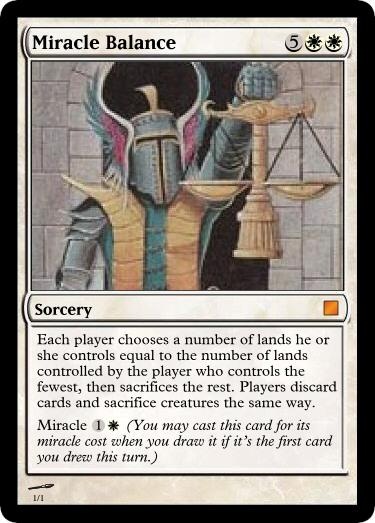
I am not positive of how good it is, but it sounds like a ton of fun. What I do know is that there is no way R&D wouldn’t have tested it, so if they didn’t print it, it had to have been for a reason…
One last note on miracles (next week is not miracle-centric, I promise!): you know what card is real good with miracles?Â
Desolate Lighthouse is definitely a rival to Kessig Wolf Run, Gavony Township, Moorland Haunt, Nephalia Drownyard, and Vault of the Archangel in terms of power. A land that comes into play untapped and continues to give you selection over time is incredible in this world of flashback and situational answers. However, it is particularly exciting with miracles.
First of all, it lets you draw exactly one extra card each turn during your opponent’s turn, giving you double the chances to hit a miracle. Second, it lets you loot away your expensive miracles when they aren’t good. That is the exact thing you want! This card single-handedly raises the level of heavy miracle decks and ensures that dedicated miracle decks that aren’t just playing the “good ones” (like Bonfire, Entreat, and Terminus) are going to exist and have a real place in the metagame.
It’s going to be a pretty wild and crazy next few months, but miracles are not the only contributing factors. What are the two cards you would most want to see discussed next week? I have at least eleven cards that I am super excited to get into that are very hot debates (or should be), plus a host of role players that offer some interesting puzzles to solve. Let me know your top two in the comments, and I’ll catch you back here next week!
Patrick Chapin
“The Innovator”

